In the heart of the enchanting Kashmir Valley, where the snow-capped Himalayas stand tall and the pristine Dal Lake reflects the sky's brilliance, a different kind of beauty unfolds. Here, in this picturesque paradise, the art of Kashmiri shawl embroidery has flourished for centuries. It has spread like a fragrant bloom amidst the valley's resplendent landscapes. The exquisite craft of adorning shawls with intricate patterns and motifs has become an integral part of the Kashmiri cultural tapestry. In fact, each of these shawls is more than just a piece of clothing; it's a living testament to history, culture, and the indomitable spirit of craftsmanship.
So, as we embark on this journey, we step into a world where stories are not told or written. Instead, artisans weave these stories, thread by thread, onto the canvas of shawls. These aren't just patterns; they are narratives of love, life, and landscapes. The delicate stitches hold tales of beauty, nature's bounty, and the rich heritage of Kashmir.
Kashmir and Shawls
The art of Kashmiri shawl embroidery has transcended the boundaries of time, connecting not only generations but also cultures. It is, hence, a universal language of artistry, appreciated by connoisseurs and collectors worldwide. These shawls bear the weight of history with grace and tell stories of the hands that crafted them, the hearts that cherished them, and the traditions that still breathe through each intricate design.
So, we unveil the world of Kashmiri shawl embroidery, a realm where every thread tells a tale. Moreover, there are narrations of artistic brilliance, cultural richness, and the enduring spirit of a valley that is, in itself, a masterpiece of nature. Through this journey, we will explore the roots of this art, the motifs that carry profound meaning, the craftsmanship that demands patience and precision, and the artisans who are the custodians of tradition. So, let's dive into this enchanting world. Here artisans weave history, culture, and craftsmanship, creating a fabric as rich as the tales it tells.
The Roots of Kashmiri Shawl Embroidery
The enchanting world of Kashmiri shawl embroidery is a narrative woven through the annals of time. Its origins stretch back centuries, finding their roots in the rich cultural tapestry of Kashmir. In this breathtaking landscape, where nature's beauty knows no bounds, aesthetics and artistry have, indeed, been there for generations.
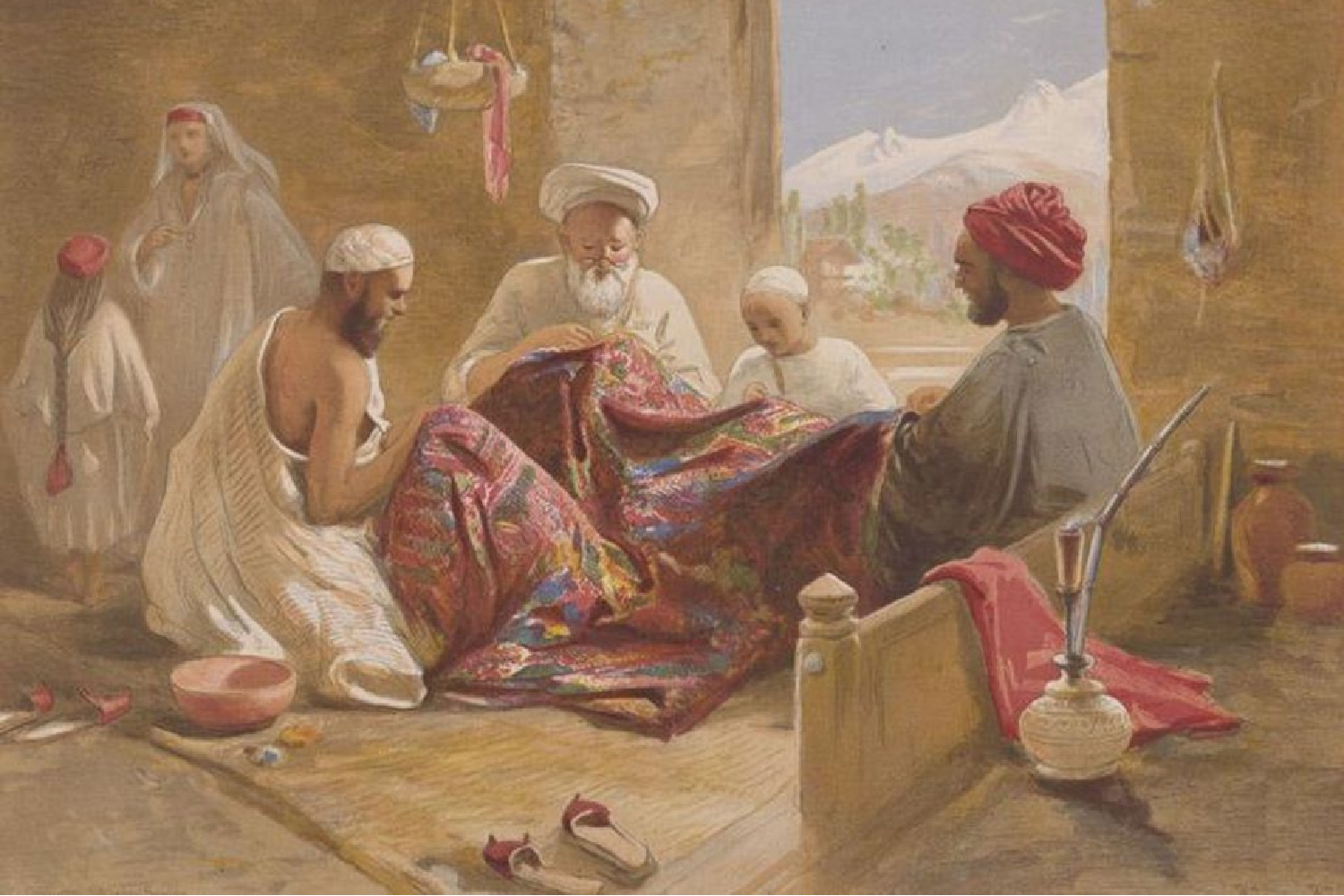
At the heart of this timeless tale are the exquisite shawls, known as 'Pashmina shawls. These shawls have been there as integral parts of Kashmiri heritage. These are, hence, more than just clothing. In fact, for the locals, they are the embodiment of a culture where artistry thrives in every corner. Their journey, from raw wool to luxurious drapery, is a saga that pays homage to human skill and unfaltering patience.
The valley of Kashmir, surrounded by the grandeur of the Himalayas, boasts an atmosphere where creativity thrives in harmony with the serene natural beauty. It's a land where artistry is not a mere pastime but a way of life, deeply interwoven with the region's identity. In this enchanting realm, the story of shawl embroidery is a testament to the enduring spirit of craftsmanship.
With each intricate stitch, these shawls carry forward the legacy of a culture that has preserved the art of embroidery with love and dedication. They hold within them the whispers of artisans who, generation after generation, have perfected the delicate craft. The roots of Kashmiri shawl embroidery run deep, nourished by the fertile soil of tradition and the pure waters of artistic passion. Hence, this art is not just an adornment but a piece of history that continues to unfurl its elegance across time, connecting us to a heritage as timeless as the art itself.
Cashmere - The Opulent Canvas

When it comes to Pashmina shawl embroidery, Cashmere stands as the exquisite canvas upon which artists etch artistry. It is a fabric famous not only for its exceptional softness but also for the comforting warmth it offers. It comes from the underbelly of the Changthangi goat and is indeed a treasure that herders collect from the high-altitude regions of the Himalayas. The journey of Cashmere begins with the Changthangi goat, a resilient and majestic creature that thrives in the challenging terrain of the Himalayan mountains. It's in the inner fleece of this magnificent animal that the secret of Pashmina's extraordinary softness lies. Collected with care and respect, artisans later transform the wool into a canvas, a canvas as soft as a lover's whisper.
The process of creating Cashmere fabric is a labour-intensive art in itself. Artisans first meticulously clean the wool, with great attention to detail, to ensure that it is free from impurities. They then spin it by hand, into fine threads, a task that requires skill, patience, and dedication. The resulting threads are as delicate as gossamer, promising an ethereal experience when draped around the shoulders. Artisans weave these fragile threads into delicate fabric with immense patience and love. The artistry lies not only in the intricate embroidery but also in the creation of this canvas. The softness of Pashmina is legendary, often compared to a lover's tender whisper, and its warmth is like an embrace on a wintry day.
Cashmere is a testament to nature's finest craftsmanship. It is a reminder that even the softest whispers of nature can transform into a canvas of unparalleled beauty. And, in the hands of skilled artisans, this canvas becomes a masterpiece.
Sozni - The Art of Intricate Needlework on Kashmiri Shawl
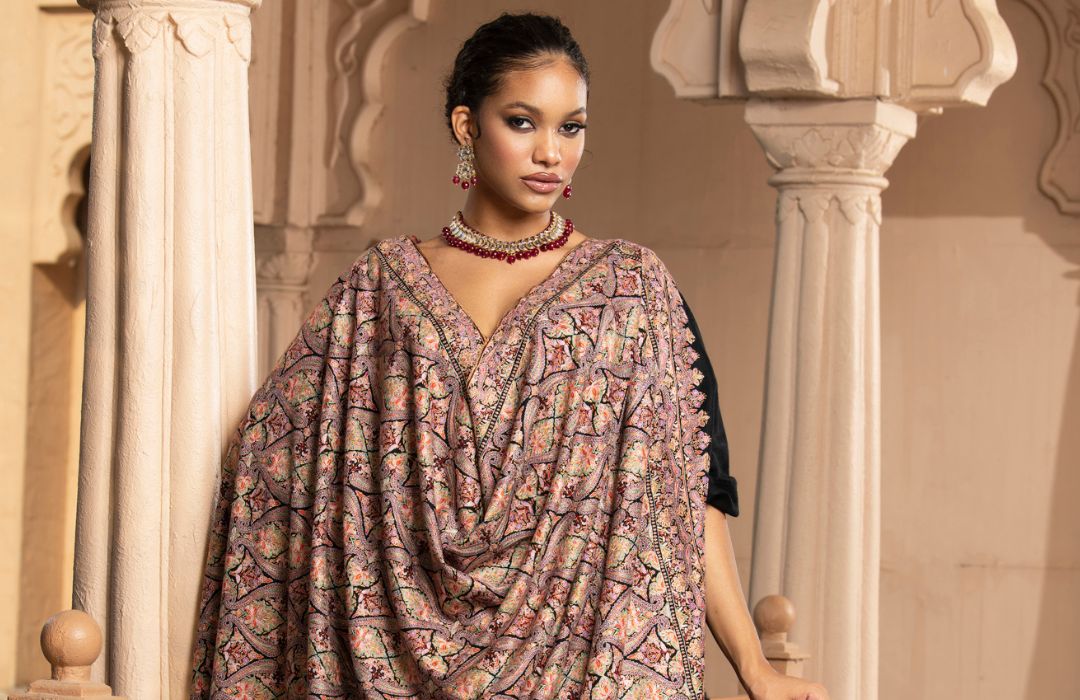
In the realm of Kashmiri shawl embroidery, there exists a gem that shines brighter and more intricate than the rest – "Sozni" embroidery. Sozni is not just a craft; it is a labour of love, a testament to the artistic brilliance that has graced Kashmir for centuries. This exquisite form of needlework is the crowning jewel of Kashmiri shawl embroidery. Sozni, a term that translates to "needle" in Persian, is aptly named. It is a meticulously detailed embroidery technique that requires a high degree of precision and skill. Furthermore, the process of Sozni embroidery is a journey that unfolds with grace and meticulous care.
Process of Sozni embroidery
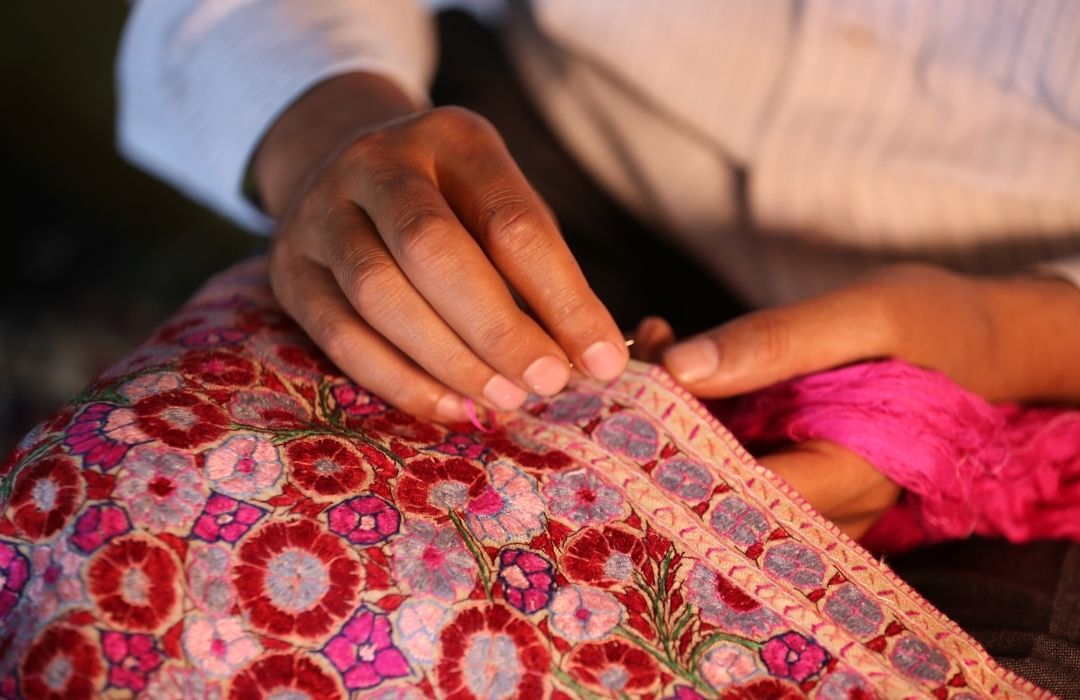
The Sozni embroidery process is a painstaking and intricate craft that involves several steps. But many aren't aware of this luxury process. So, for them, here's an overview of how artisans execute Sozni embroidery traditionally:
- Design Selection: To begin with, artisans select a design. These designs have deep roots in tradition, inspired by nature, or else passed down through generations. The chosen design serves as a blueprint for the embroidery.
- Tracing the Design: Artisans then carefully trace the selected design onto the Pashmina canvas. This step ensures that the intricate pattern is accurately shown on the fabric.
- Preparing the Canvas: Now, workers stretch and secure the Cashmere canvas onto a wooden frame. This provides stability for the delicate needlework that follows in addition to ensuring that the fabric remains taut.
- Thread Selection: Artisans, who are often women, select the appropriate threads for the embroidery. These threads can be made of colourful silk or fine Pashmina yarn, depending on the desired effect.
- Needlework: The actual embroidery process begins as artisans thread their needles with the chosen thread. Next, they use the traced design as a guide. They then execute each stitch with utmost precision, maintaining the perfect tension and spacing. And, this ensures the desired pattern is achieved. Sozni embroidery is famous for its intricate stitches. These may include variations like chain stitches, satin stitches, or even tiny knots. Artisans execute each stitch with care, adding layer upon layer of detail to the design.
- Meticulous Detail: The artisan's skill is showcased as he works meticulously to fill in the design with vibrant colors and intricate patterns. Note that this step can take an extended period, often spanning months, depending on the complexity of the design.
The Supremacy of Sozni
What truly sets Sozni apart is the artistry and dedication of the artisans who breathe life into this craft. These skilled craftsmen, often women, thread their needles with vibrant silk or wool yarn; they use a contrasting thread as a guide. The canvas comes alive with each meticulously executed stitch, requiring a level of precision that is perfect.
Sozni embroidery is a laborious and time-consuming process. It's not uncommon for a single shawl to demand months of painstaking labour. But the result is a masterpiece of intricate beauty, with patterns ranging from delicate florals to majestic paisleys and celestial designs.
None can overstate the importance of artisans in the realm of Sozni embroidery. They are the heart and soul of this craft, preserving a tradition that has come down through generations. It is truly their patience, dedication, and skill, that ensures each stitch is executed with the utmost precision and finesse. Their hands indeed maintain the delicate balance that defines Sozni.
Hence, Sozni is not just an embroidery technique; it's a cultural legacy, a reflection of the enduring spirit of the people of Kashmir. Each Sozni-embroidered piece is a work of art, a testament to the artistry, tradition, and unwavering dedication of the artisans who continue to enchant the world with their craft.
The Regal Shimmers of Tilla
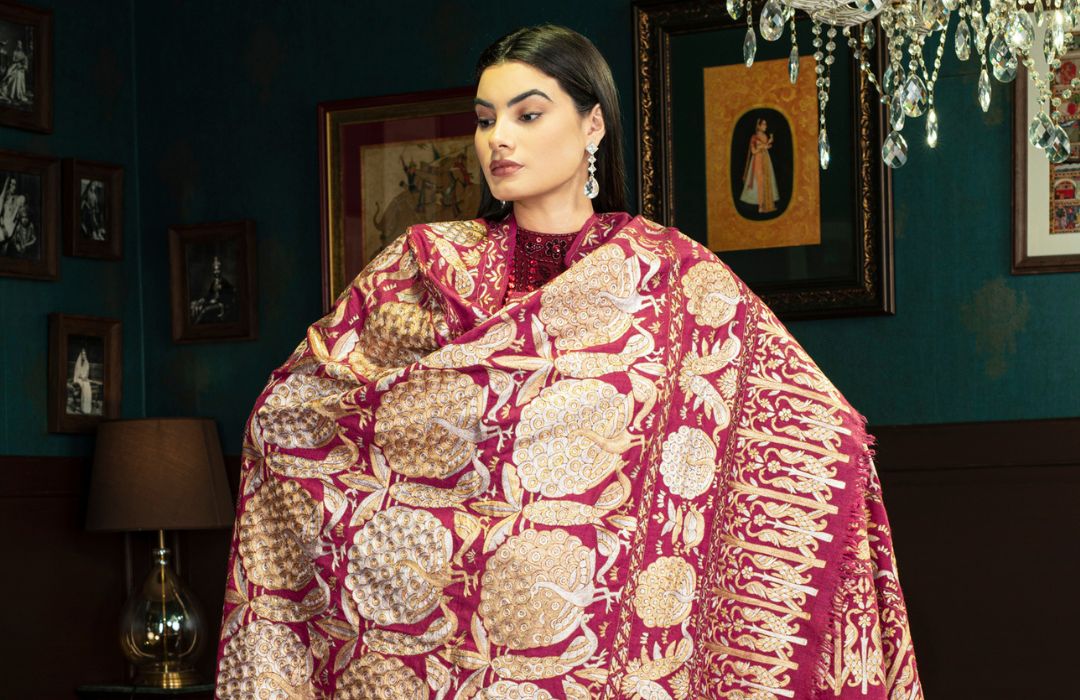
Among the myriad of exquisite Kashmiri shawl embroideries, "Tilla" stands as the epitome of luxury and elegance. Tilla embroidery is characterized by incorporating thin metal threads, often in silver or gold, into the fabric. This meticulous process results in shawls and garments that gleam with a regal sheen, hence, evoking an air of sophistication and luxury.
Tilla embroidery has a rich historical significance. It was highly favoured by the Mughal emperors who ruled India. In fact, they adorned their courts with resplendent Tilla-embroidered textiles. This artistry became synonymous with royalty, reflecting the grandeur and extravagance of the Mughal era. Tilla embroidery even today remains a symbol of luxury and craftsmanship, a testament to the enduring legacy of Kashmiri artistry. Hence, Tilla is not just a form of embroidery, but a representation of a rich history and an art form that continues to captivate and inspire, transcending time and culture.
Process of Tilla embroidery
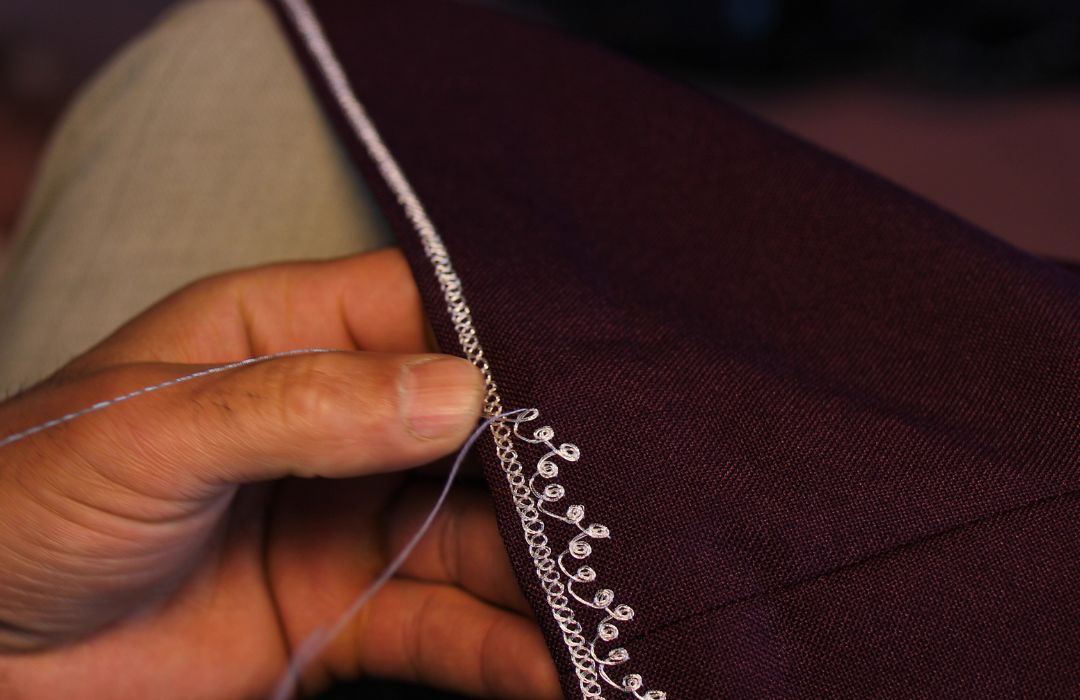
The process of Tilla embroidery is a carefully choreographed dance of precision and artistry. Artisans execute each step with exceptional care, ensuring that the metal threads are flawlessly integrated into the fabric:
- Design Selection: To begin with, artisans select a design, just like in other Kashmiri embroidery styles. These designs can be intricate florals, geometrical patterns, or motifs that are inspired by Mughal art and architecture.
- Marking the Pattern: Once artisans choose the design, they mark it onto the Cashmere or other fabric. The markings provide a guideline for the placement of the metal threads.
- Metal Thread Selection: The heart of Tilla embroidery is the metal thread, often made of pure silver or gold. These threads are incredibly thin and, hence, require a delicate touch to work with.
- Needlework: Artisans use a fine needle to meticulously sew the metal threads into the fabric. This process is akin to creating a delicate tapestry, with each stitch carefully securing the metal thread.
- Tight Weaving: The metal threads are woven tightly into the fabric to ensure they stay in place and do not unravel.
- Layering: To create the desired effect and depth, artisans layer the metal threads, hence adding to the complexity and luxury of the design.
- Final Touches: After the metal threads are securely in place, artisans make any final adjustments or refinements to the design.
The resulting Tilla-embroidered fabric is a work of art that exudes a sense of grandeur and elegance. The shimmering silver or gold threads catch the light, creating a play of radiance that is nothing short of breathtaking.
The Language of Motifs: Kashmiri Shawl Motifs
In the enchanting world of Kashmiri shawl embroidery, every motif, every stitch, weaves a unique tale that speaks of love, nature, and spirituality. These motifs are more than just decorative elements; they are carriers of cultural heritage and profound symbolism. Let's delve into the rich language of motifs that adorn the exquisite fabric of Kashmiri shawls.
Paisley: The Symbol of Life
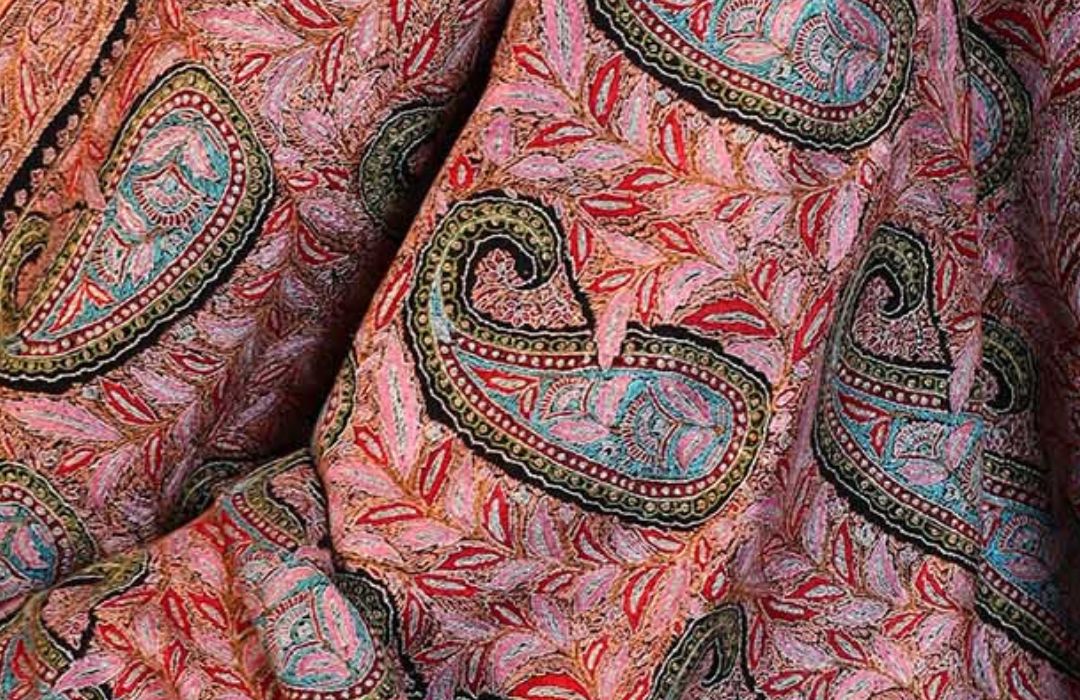
At the heart of Kashmiri shawl embroidery lies the iconic paisley motif, known as "both" in Persian. This timeless design represents life and eternity, making it a central motif in many Kashmiri shawl patterns. Often seen as a symbol of the "tree of life," the paisley motif embodies the cycle of existence, growth, and renewal. In other words, it carries with it the promise of enduring life and the eternal beauty that shawls hold.
The graceful curvature of the paisley design, resembling a teardrop or a young shoot, exudes a sense of vitality and youthfulness. It is a testament to the artisan's skill and artistry in creating a motif that resonates with the profound interconnectedness of all living things. As a part of the Kashmiri shawl embroidery tradition, paisley adds an element of life and vibrancy to the fabric, making it not just an accessory but a reflection of existence itself.
Chinar Leaves: The Essence of Kashmir
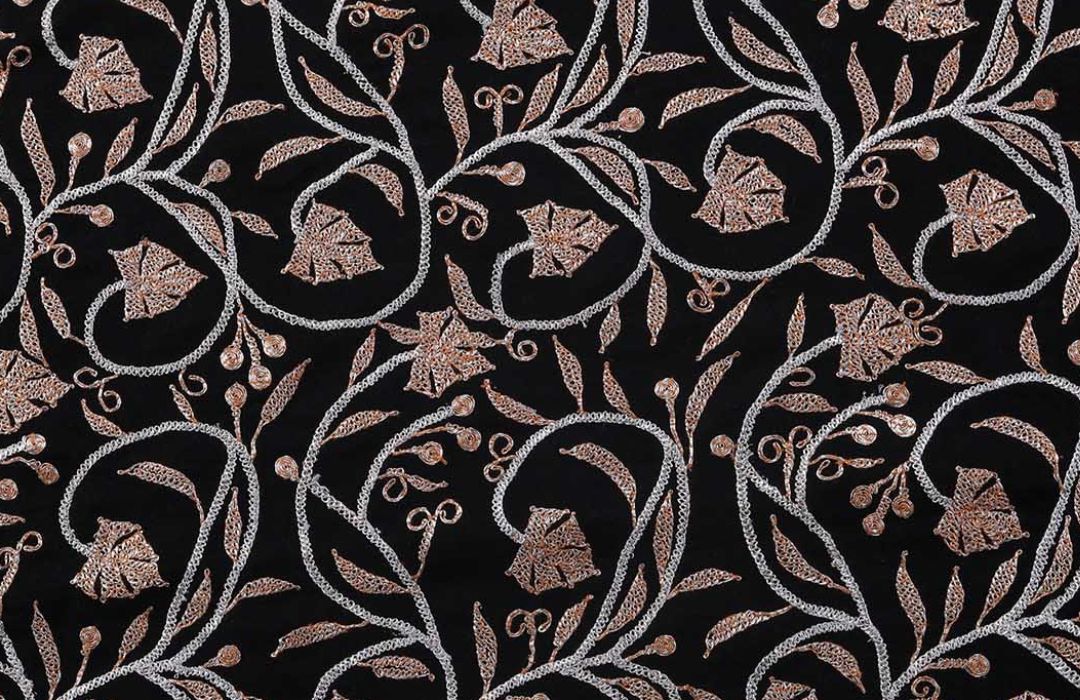
The Chinar leaf motif pays homage to the majestic Chinar trees that adorn the Kashmir Valley. These trees, with their vibrant crimson leaves in autumn, are synonymous with the beauty of the region. They are a symbol of Kashmir's essence in addition to being an expression of the deep-rooted love that Kashmiris hold for their homeland.
The Chinar leaf motif in Kashmiri shawl embroidery showcases the reverence for nature besides the strong bond that the people of the valley share with their land. It's as if each embroidered leaf whispers a love story about the land's beauty and the respect it commands. The Chinar leaves not only add visual splendour to the shawls but also serve as a reminder of the profound connection between the people of Kashmir and their beloved homeland.
Euphorbia Flowers: Symbol of Renewal
Euphorbia flowers are a recurring motif in Kashmiri shawl embroidery. These exquisite flowers symbolize renewal and the cyclical nature of life. Just as the seasons change and nature renews itself, so too do our lives go through cycles of growth, transformation, and rebirth. The presence of euphorbia flowers in shawl patterns serves as a reminder of the eternal beauty of the natural world, in addition to the enduring spirit of life.
Each euphorbia flower is meticulously embroidered, showcasing the skill and dedication of the artisans. It's as if these delicate blossoms breathe life and renewal into the fabric, thus, creating a connection between the wearer and the eternal cycles of nature.
Kashmiri shawl embroidery is not just a craft but a profound language of art and culture. The motifs that grace these shawls are more than embellishments; they are symbols of life, love, and spirituality. They transform each shawl into a canvas of stories, making it not just a piece of clothing but a testament to the enduring traditions and beauty of Kashmir.
Kashmiri Embroidery - The Exquisite Craftsmanship
Kashmiri shawl embroidery is more than just a craft; it's a labour of love that demands an extraordinary degree of skill, time, and unwavering dedication.
The Artisans: Masters of Their Craft
The artisans practising Kashmiri shawl embroidery often hail from a hereditary tradition where skills are passed down through the generations. These master artisans, the custodians of a rich heritage, commit their lives to perfecting the art of Sozni and Tilla embroidery. Their journey begins at a young age, learning the intricacies of design, the nuances of threadwork, and the secrets of stitch-by-stitch magic. Hence their work is a profound connection to their roots and an unwavering devotion to the craft.
The Process: Stitch by Stitch
The meticulous process of Kashmiri shawl embroidery is a symphony of artistry and precision. Artisans transfer intricate designs skillfully onto the fabric, often without patterns, as the artisans work freehand. This, hence, demands a steady hand, an acute sense of detail, and a deep connection to the art. The actual embroidery itself is a slow and painstaking endeavour, where each stitch contributes to the shawl's final masterpiece. The motifs come to life under the artisans' nimble fingers, and as they move their needles, they weave stories into each thread.
Time and Patience: A Priceless Investment
Kashmiri shawl embroidery is the embodiment of patience and perseverance. It's a labour-intensive art form where time is both an ally and a challenge. It can take months to complete a single shawl, depending on its complexity and the artistry involved. The dedication of the artisans is remarkable, their willingness to invest the gift of time into each creation is a testament to their commitment to preserving this cultural treasure. They understand that true art cannot be rushed, but must be nurtured and allowed to flourish at its own pace.
The result of this exceptional craftsmanship is more than a beautifully embroidered shawl; it's a testament to the enduring legacy of the artisans. Their work not only creates exquisite pieces of art but also sustains a tradition that has been passed down through generations. Each shawl they craft is a labour of love, a masterpiece of patience, and a testimony to the profound connection between art, culture, and the hands that create it.
Preserving Tradition
In an era dominated by fast fashion, where trends come and go in the blink of an eye, Kashmiri shawl embroidery stands as an unwavering beacon of tradition and heritage. It serves as a testament to the enduring power of human artistry in the face of the relentless passage of time.
Empowering Artisans
Kashmiri shawl embroidery isn't just a celebration of art; it's a lifeline for many artisans. These skilled craftspeople are the custodians of a living tradition, and by supporting their work, we contribute to the preservation of a unique cultural heritage. The art of Kashmiri embroidery isn't confined to history books; it's a living legacy, handed down from one generation to the next. Each stitch they create is a link to their ancestors, a bridge to the past, and a promise for the future. By investing in their craft, we empower these artisans to keep their traditions alive.
A Global Icon
The allure of Kashmiri shawl embroidery knows no boundaries; it transcends borders and resonates with people from all walks of life. It's cherished by individuals around the world who recognize the value of this timeless art form. Whether worn as a symbol of elegance, draped as a shroud of warmth, or gifted as a token of love, these shawls hold a special place in the hearts of many. They're not just pieces of fabric; they're a testament to the rich tapestry of human culture. As these shawls journey from the artisans' hands to the world, they carry with them a piece of the tradition and heritage they represent. Kashmiri shawl embroidery is not merely an art form; it's a cultural ambassador that fosters understanding and appreciation among diverse communities.
Also read: THE ROLE OF PASHMINA IN BRIDAL FASHION
Conclusion
In a rapidly changing world, where the old often makes way for the new, Kashmiri shawl embroidery remains a steadfast symbol of heritage. It continues to remind us of the beauty of tradition in addition to the importance of preserving the artistic treasures that connect us to our roots.
The roots of Kashmiri shawl embroidery run deep, reaching back through centuries of tradition and artistry. The canvas for this magnificent work, Cashmere, is as soft as a lover's whisper and as warm as a mother's embrace. Sozni, with its intricate needlework, and Tilla, gilded with elegance, are indeed the stitches that bring these stories to life.
The motifs, each carrying its own significance, form a language that speaks of love, nature, and spirituality. As we delve into the language of motifs, we discover that every design is a piece of a greater narrative, a tale of life, Kashmir, and the eternal beauty of the natural world.
The craftsmanship involved in Kashmiri shawl embroidery is not merely a craft; it's a labour of love, a commitment to perfection that spans generations. The artisans, the unsung heroes of this art, dedicate their lives to preserving a tradition that is both rich and fragile.
In an age where trends come and go, and fast fashion often overshadows the beauty of tradition, Kashmiri shawl embroidery remains an unwavering symbol of heritage. It's a reminder of the enduring power of artistry, a testament to the importance of preserving cultural legacies, and a celebration of the stories woven into every stitch.
Also read: PASHMINA: A SYMBOL OF FEMININE EMPOWERMENT